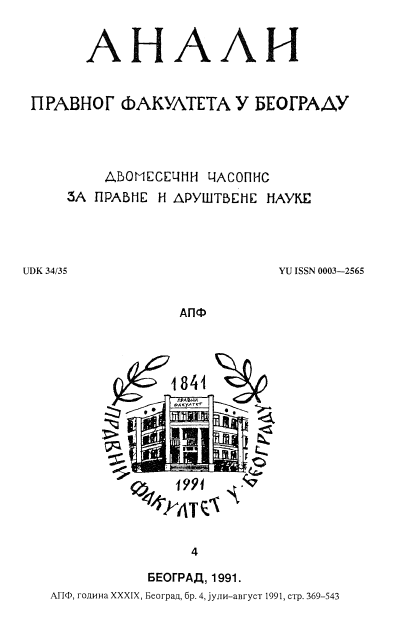РУЧНИ ДЕВЕРИ И БРАК СА МАНУСОМ
SO-CALLED "HAND" BROTHERS-IN-LAW AND THE MARRIAGE WITH "MANUS"
Author(s): Milutin ĐuričićSubject(s): Civil Law
Published by: Правни факултет Универзитета у Београду
Keywords: Marriage;Brothers-in-law; Customary law;Albanians; Mancipatio;Manus
Summary/Abstract: The subject matter of the present article is tire marriage ceremony through a sponsor, a representative, which is called by Serbs "hand" brother-in-law, and by Albanians kunat. During the tribal organisation of society, vendetta inter—tribal xenophobia and ritual cannibalistic eutlianasia, sucessors and illegitimate children were put under who killed their légitimât fathers and then were killed themselves. Out of fear of death, legitimate husbands killed, for every prematrital and marital adulteiy of their wives, their partners. There existed a genuine circle of death which as still going on with Muslim Albanians even today. Marriage represented a xenophobic danger and was concluded without "hand" brothers-in-law, without manus. Judeo-Christian culture wanted to introduce more humanity into that sacral circle. As with mancipatio in case of the transfer of ownership in the sphere of property in Roman Law, special mancipatio was introduced also in marriage ceremony. A sponsor was requested for the virginity of the bride. The sponsor was found in the "hand" brothers-in-law, namely the closest blood relatives of the husband. Brothers have handed over their sister to "hand" brothers-in-law who, after sleeping several nights with the bride, have handed her over to the husband. The husband was not able to object to his brothers that they have deflowered the sister-in-law, and they, in their turn, were responsible that she was received from the hands of her brothers as virgo intacta. In such a way vendetta was avoided due to defloration of the bride. This custom existed until recently in Montenegro, Serbia, Hercegovina and with Albanians—Catholics in the towns. This is called by the author a marriage with manus. Initial form was the marriage without manus. The one with manus came later and was practiced to save inter—tribal alliances through marriages. Later on this became a wide practice and such type of marriage (with manus) represented a progress along the long historical road of emancipation of women. Today the marriage ceremony with brothers-in-law - marriage attendants is but a sheer form, without the original substance. Spouses come to know each other before marriage, so that they become close, and the husbands do not protest the defloration of their wives. And the attendants at the marriage ceremony hand over immediately the bride to the husband.
Journal: Анали Правног факултета у Београду
- Issue Year: 39/1991
- Issue No: 4
- Page Range: 430-436
- Page Count: 7
- Language: Serbian

